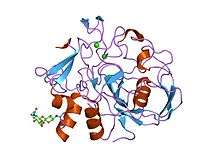Formylglycine-generating enzyme
| Formylglycine-generating enzyme | |||||||||
|---|---|---|---|---|---|---|---|---|---|
| Identifiers | |||||||||
| EC number | 1.8.99 | ||||||||
| Databases | |||||||||
| IntEnz | IntEnz view | ||||||||
| BRENDA | BRENDA entry | ||||||||
| ExPASy | NiceZyme view | ||||||||
| KEGG | KEGG entry | ||||||||
| MetaCyc | metabolic pathway | ||||||||
| PRIAM | profile | ||||||||
| PDB structures | RCSB PDB PDBe PDBsum | ||||||||
| |||||||||
| Formylglycine-generating enzyme | |||||||||
|---|---|---|---|---|---|---|---|---|---|
 formylglycine generating enzyme c336s mutant covalently bound to substrate peptide lctpsra | |||||||||
| Identifiers | |||||||||
| Symbol | FGE-sulfatase | ||||||||
| Pfam | PF03781 | ||||||||
| InterPro | IPR005532 | ||||||||
| |||||||||
Formylglycine-generating enzyme (FGE) is the name for an enzyme that catalyzes the conversion of cysteine to formylglycine (fGly). There are two main classes of FGE, aerobic and anaerobic. FGE activates sulfatases, which are essential for the degradation of sulfate esters. The catalytic activity of sulfatases is dependent upon a formylglycine (sometimes called oxoalanine) residue in the active site.[1]
Aerobic
The aerobic enzyme has a structure homologous to the complex alpha/beta topology found in the gene product of human sulfatase-modifying factor 1 (SUMF1). Aerobic FGE converts a cysteine residue in the highly conserved consensus sequence CXPXR to fGly.
Anaerobic
The most well-studied anaerobic FGE is the bacterial AtsB, an iron-sulfur cluster containing enzyme that is able to convert either cysteine or serine to fGly with a distinctly different mechanism than the aerobic form.
Protein Domain
In molecular biology, ""formylglycine-generating enzyme"" (sometimes annotated as formylglycine-generating sulfatase enzyme) is the name of the FGE protein domain, whether or not the protein is catalytically active.
Disease States
In humans, mutations in SUMF1 result in defects in FGE, which in turn causes the impairment of sulfatases. The result is a disease called multiple sulfatase deficiency (MSD), in which the accumulation of glycoaminoglycans or sulfolipids can cause early infant death.[2][3][4] Known substrates for SUMF1 are: N-acetylgalactosamine-6-sulfate sulfatase (GALNS), arylsulfatase A (ARSA), steroid sulfatase (STS) and arylsulfatase E (ARSE). SUMF1 occurs in the endoplasmic reticulum or its lumen.
References
- ↑ Roeser D, Dickmanns A, Gasow K, Rudolph MG (August 2005). "De novo calcium/sulfur SAD phasing of the human formylglycine-generating enzyme using in-house data". Acta Crystallogr. D. 61 (Pt 8): 1057–66. doi:10.1107/S0907444905013831. PMID 16041070.
- ↑ Fraldi A, Biffi A, Lombardi A, Visigalli I, Pepe S, Settembre C, Nusco E, Auricchio A, Naldini L, Ballabio A, Cosma MP (April 2007). "SUMF1 enhances sulfatase activities in vivo in five sulfatase deficiencies". Biochem. J. 403 (2): 305–12. doi:10.1042/BJ20061783. PMC 1874239
 . PMID 17206939.
. PMID 17206939. - ↑ Diez-Roux G, Ballabio A (2005). "Sulfatases and human disease". Annu Rev Genomics Hum Genet. 6: 355–79. doi:10.1146/annurev.genom.6.080604.162334. PMID 16124866.
- ↑ Sardiello M, Annunziata I, Roma G, Ballabio A (November 2005). "Sulfatases and sulfatase modifying factors: an exclusive and promiscuous relationship". Hum. Mol. Genet. 14 (21): 3203–17. doi:10.1093/hmg/ddi351. PMID 16174644.
This article incorporates text from the public domain Pfam and InterPro IPR005532